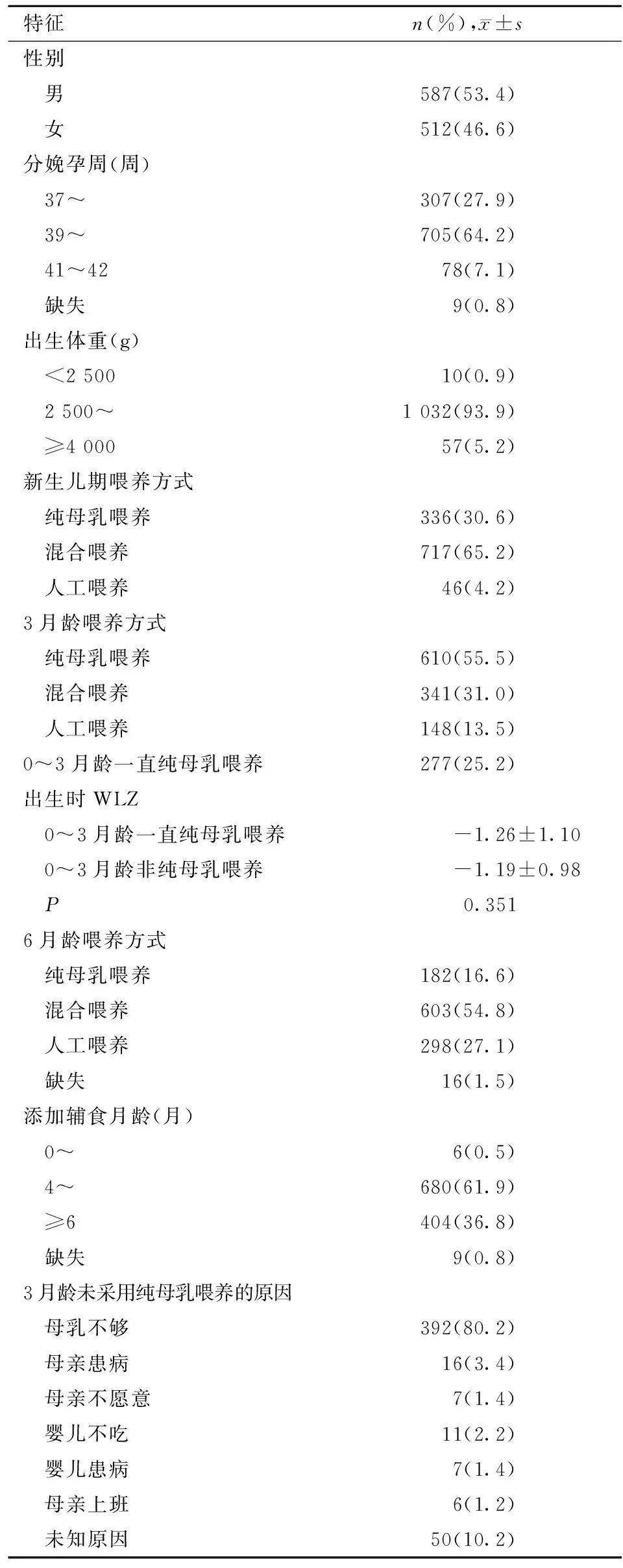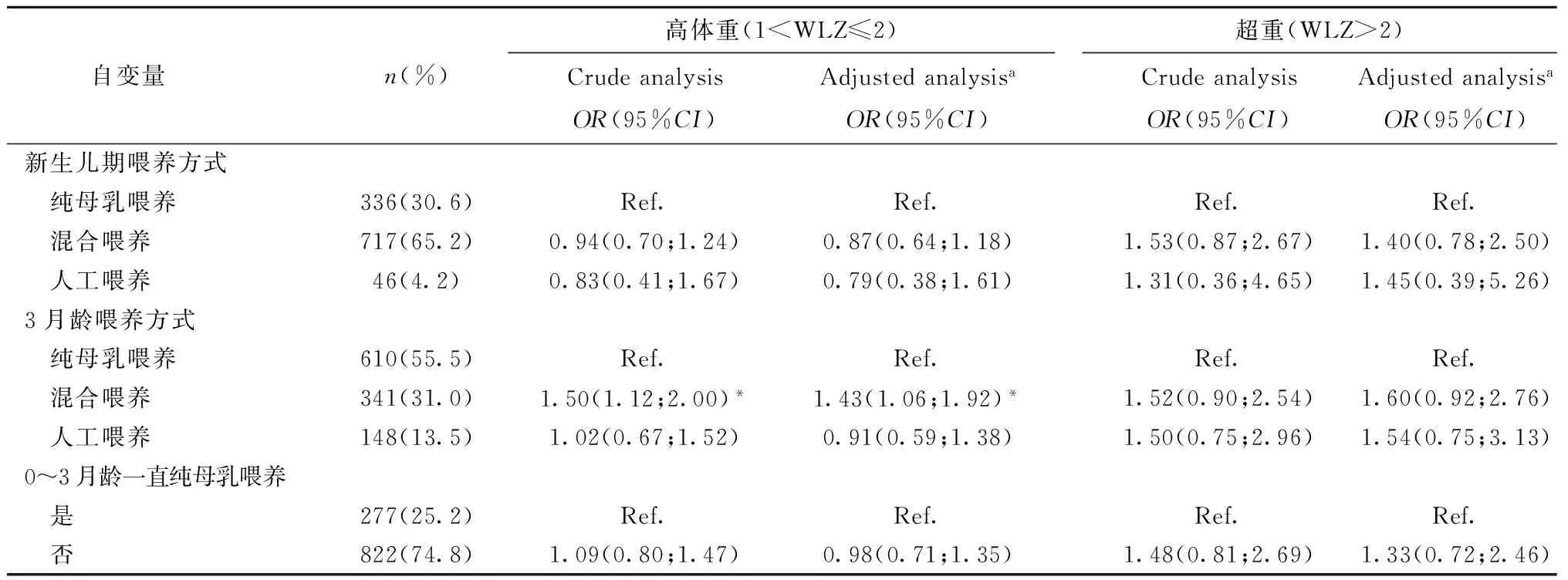0~3月龄不同喂养方式对婴儿期体格发育的影响*
黄俊美, 吴远珏, 汪 静, 周 莉, 倪泽敏, 郝丽萍, 杨年红△, 杨雪锋△
1华中科技大学同济医学院公共卫生学院营养与食品卫生学系,食品营养与安全湖北省重点实验室,武汉 430030 2武汉市江岸区妇幼保健院,武汉 430014 3武汉市江岸区疾病预防控制中心,武汉 430014
0~3月龄不同喂养方式对婴儿期体格发育的影响*
黄俊美1, 吴远珏1, 汪 静2,3, 周 莉2, 倪泽敏2, 郝丽萍1, 杨年红1△, 杨雪锋1△
1华中科技大学同济医学院公共卫生学院营养与食品卫生学系,食品营养与安全湖北省重点实验室,武汉 4300302武汉市江岸区妇幼保健院,武汉 4300143武汉市江岸区疾病预防控制中心,武汉 430014
目的 探讨不同的喂养方式对婴儿生长发育的影响。方法 选取武汉市某区1 099名婴儿,在新生儿期、3月龄、6月龄和12月龄分别测量体重和身长,并对其喂养情况进行问卷调查。采用WHO Anthro软件计算年龄别体重的Z评分(WAZ)、年龄别身长的Z评分(LAZ)、身长别体重的Z评分(WLZ)和年龄别体质量指数的Z评分(BAZ)。结果 该研究中新生儿期纯母乳喂养率30.6%;3月龄纯母乳喂养率55.5%;0~3月龄一直纯母乳喂养率25.2%。6月龄纯母乳喂养率16.6%。6月龄前添加辅食占62.4%。婴儿身长和体重至3月龄后均高于WHO参考值。与WHO的正态分布曲线比较,该研究中婴儿的WLZ至3月龄以后中位数大于WHO参考值,曲线右移。WAZ、LAZ、WLZ、BAZ、高体重率和超重率均随着月龄的增大而增加。3月龄、6月龄、12月龄高体重率分别占27.3%、30.2%、28.8%;超重率分别占6.9%、10.5%、6.6%。新生儿期、3月龄及0~3月龄一直采用人工喂养和混合喂养的婴儿,至6月龄和12月龄时体格发育高于纯母乳喂养的婴儿。3月龄非纯母乳喂养组,至6月龄和12月龄时高体重率显著高于纯母乳喂养组(P<0.05)。0~3月龄一直非纯母乳喂养组,至6月龄时高体重率显著高于纯母乳喂养组(P<0.05),至12月龄时,超重率也高于纯母乳喂养组,但差异无统计学意义(P>0.05)。Logistic回归分析结果表明,3月龄时采用混合喂养为6月龄(OR=1.35,95%CI:1.00~1.81)与12月龄(OR=1.43,95%CI:1.06~1.92)时高体重发生的危险因素。结论 纯母乳喂养有利于婴儿的正常生长发育,早期坚持纯母乳喂养有利于预防婴儿晚期发生超重。
喂养方式; 生长发育; Z评分; 超重
母乳是婴儿生长发育最理想的食物,母乳不仅各种营养成分丰富,易于消化吸收,还含有各种免疫因子及生长因子,能提高婴幼儿免疫力,并且母乳的能量和营养素与婴儿的需要相适应,能降低婴幼儿发生肥胖的风险[1]。WHO推荐对0~6月龄婴儿进行纯母乳喂养[2],在没有母乳或母乳不足时可添加配方奶。现有研究发现,混合喂养或人工喂养虽然能满足新生儿的营养需求,但是容易造成营养过剩,增加其儿童期或成年期超重或肥胖的风险[3]。为在我国全面提倡纯母乳喂养,中国营养学会发布《6月龄内婴儿母乳喂养指南》[4],提出坚持6月龄内采用纯母乳喂养。本研究对武汉市某区0~3月龄婴儿的喂养方式进行了调查,并对喂养方式与12月龄内婴儿生长发育的关系进行了初步探讨,为进一步提倡纯母乳喂养提供理论依据。
1 资料与方法
1.1 研究对象
选取从2014年2月至2016年6月在武汉市某区妇幼保健院儿童保健科门诊常规健康体检的0~12月龄婴儿及其父母作为调查对象。婴儿的出生信息包括:性别、分娩孕周、分娩方式、出生体重和身长,来自于武汉妇幼保健院信息系统。按照下列标准纳入:①孕周>37周且<42周的足月儿。②母亲妊娠期胎儿无宫内发育异常、无妊娠合并症、产程顺利。③新生儿期无先天性疾病,如先天性心脏病、呼吸道疾病等。④出生时Apgar评分≥8分。排除有慢性腹泻、结核、肺炎、肾病等的婴儿,选取1 099例健康新生儿进行喂养方式调查和生长发育分析。
1.2 体格测量
由培训过的专职儿童保健医师在新生儿期(14 d左右)、3月龄、6月龄和12月龄时统一测量婴儿的体重、身长并记录。体重以千克(kg)为单位,至小数点后l位;身长采取仰卧位以厘米(cm)为单位,至小数点后1位。
1.3 喂养方式调查
在体检的同时,对婴儿的健康状况和喂养方式进行问卷调查。将喂养方式分为:①纯母乳喂养:只给婴儿提供母乳,不提供配方奶。②混合喂养:出生以后母乳喂养同时加配方奶。③人工喂养:完全不使用母乳喂养,婴儿的喂养由配方奶代替。
1.4 体格发育水平评价
以WHO 2006新标准作为参考标准,分别在WHO Anthro软件(Version 3,2009)中录入性别、出生日期、测量日期及身长、体重数据,计算按年龄别体重Z评分(weight-for-age z-score,WAZ)、年龄别身长Z评分(length-for-age z-score,LAZ)、身长别体重Z评分(weight-for-length z-score,WLZ)和年龄别体质量指数(BMI)Z评分(BMI-for-age z-score,BAZ)。进行评价Z评分的计算公式为:Z=(观测值-参考标准的中位数)/参照人群的标准差。评价指标有:①WAZ:WAZ<-2为低体重,是判断儿童营养不良率的最常用指标;②LAZ:LAZ<-2为生长迟缓,通常反映儿童慢性营养不良;③WLZ:WLZ<-2为消瘦,-2≤WLZ≤1为正常,1
1.5 统计学方法

2 结果
2.1 一般情况
被调查的1 099例对象中,男婴587例,占53.4%;女婴512例,占46.6%。婴儿出生体重在正常范围有1 032例,占93.9%。新生儿期纯母乳喂养率30.6%;3月龄纯母乳喂养率55.5%;0~3月龄一直纯母乳喂养率25.2%。6月龄纯母乳喂养率16.6%。6月龄前添加辅食占62.4%。3月龄未采用纯母乳喂养原因中,母乳不够占80.2%,见表1。

表1 婴儿的一般情况(n=1 099)Table 1 Characteristics of infants(n=1 099)
2.2 婴儿体格发育的状况
本次调查婴儿的身长在出生后至12月龄内均高于WHO参考值[7],而体重在出生时与WHO参考值无区别,至3月龄后逐渐高于WHO参考值。WAZ、LAZ、WLZ和BAZ的基本变化趋势是随着月龄的增大而增加。婴儿的消瘦率在3月龄前比较高4.4%,3月龄后逐渐下降,至12月龄时消瘦率低至0.5%。从出生至12月龄,低体重率和生长迟缓率则一直保持较低水平,不超过0.6%。高体重率和超重及肥胖率则是随着月龄的增大而增加,3月龄、6月龄、12月龄高体重率分别占27.3%、30.2%、28.8%;超重及肥胖率分别占6.9%、10.5%、6.6%,见表2。
2.3 0~3月龄不同喂养方式对婴儿身长与体重的影响
新生儿期及3月龄时采用混合喂养,至6月龄时体重和身长均高于纯母乳喂养组,差异有统计学意义(均P<0.05);至12月龄时,混合喂养组和人工喂养组的体重和身长均高于纯母乳喂养组,差异有统计学意义(均P<0.01)。3月龄时混合喂养组及人工喂养组,至12月龄时WLZ和BAZ均显著大于纯母乳喂养组,差异有统计学意义(均P<0.05)。0~3月龄一直未采用纯母乳喂养,至6月龄和12月龄时,体重和身长均高于纯母乳喂养组,差异有统计学意义(均P<0.01);0~3月龄一直未采用纯母乳喂养,至6月龄和12月龄时,WLZ和BAZ大于纯母乳喂养组,但仅WLZ在12月龄时差异有统计学意义(P<0.05),见表3。
2.4 0~3月龄不同喂养方式对婴儿营养状况的影响
新生儿期,高体重率和超重率在纯母乳喂养组和非母乳喂养组间比较,差异均无统计学意义(均P>0.05)。而3月龄时采用非母乳喂养,至6月龄和12月龄时高体重率均高于纯母乳喂养组,差异有统计学意义(均P<0.05)。0~3月龄一直采用非纯母乳喂养,至6月龄时高体重率显著高于纯母乳喂养组,差异有统计学意义(P<0.05),至12月龄时,超重率也高于纯母乳喂养组,但差异无统计学意义(P>0.05),见表4。
以婴儿性别、分娩方式、添加辅食月龄、出生体重和身长以及母亲孕前BMI和孕期增重作为调整因素,进行Logistic回归分析。结果表明,3月龄时采用混合喂养为6月龄(OR=1.35,95%CI:1.00~1.81)与12月龄(OR=1.43,95%CI:1.06~1.92)时高体重发生的危险因素,见表5、6。
2.5 与WHO新标准参考值的WLZ正态分布曲线相比的结果
以本研究1 099名婴儿、0~3月龄采用纯母乳喂养以及非纯母乳喂养婴儿的WLZ分别与WHO新参考值正态分布曲线进行比较,在出生时,WLZ中位数接近WHO参考值,3月龄以后至12月龄,中位数大于WHO参考值,曲线右移,如图1、图2和图3所示。

表2 婴儿的体格发育情况Table 2 The physical development of infants [n=1 099,±s,n(%)]

表3 0~3月龄不同喂养方式对婴儿生长发育的影响Table 3 Effects of different feeding patterns during 0-3 months on growth and development of infants[(s)]
与新生儿期纯母乳喂养比较,*P<0.05**P<0.01;与3月龄纯母乳喂养比较,#P<0.05##P<0.01;与0~3月龄一直纯母乳喂养比较 ,△P<0.05△△P<0.01

表4 0~3月龄不同喂养方式与婴儿营养状况关系的单因素分析[n(%)]Table 4 Univariate analysis on the relationship between different feeding patterns during 0-3 months and nutritional status of infants[n(%)]
与3月龄纯母乳喂养比较,*P<0.05;与0~3月龄一直纯母乳喂养比较,#P<0.05

表5 Logistic回归分析不同喂养方式与6月龄婴儿营养状况的关系Table 5 Logistic regression analysis on the relationship between different feeding patterns and nutritional status of infants at 6 months of age
a调整因素包括婴儿性别、分娩方式、添加辅食月龄、出生体重和身长以及母亲孕前BMI和孕期增重;与3月龄纯母乳喂养比较,*P<0.05

表6 Logistic回归分析不同喂养方式与12月龄婴儿营养状况的关系Table 6 Logistic regression analysis on the relationship between different feeding patterns and nutritional status of infants at 12 months of age
a调整因素包括婴儿性别、分娩方式、添加辅食月龄、出生体重和身长以及母亲孕前BMI和孕期增重;与3月龄纯母乳喂养比较,*P<0.05

图1 1 099例婴儿在出生、3月龄、6月龄和12月龄时的WLZ与WHO正态分布曲线的比较Fig.1 The WLZ in 1 099 infants at 0,3,6 and 12-months of age were compared with the normal distribution curves of WHO references

图2 277例0~3月龄一直纯母乳喂养婴儿在出生、3月龄、6月龄和12月龄时的WLZ与WHO正态分布曲线的比较Fig.2 The WLZ in 277 infants with exclusive breastfeeding during 0-3 months old at 0,3,6 and 12-months age were compared with the normal distrbution curves of WHO references
3 讨论
婴儿的生长发育与喂养方式的关系密切,正确的喂养方式不仅可以给婴儿提供能量及必需的营养物质,而且可预防婴儿晚期的超重和肥胖的发生[8]。本研究结果显示,混合喂养组和人工喂养组的体重和身长至6月龄和12月龄时均高于纯母乳喂养组,与多项研究结果相似[9-10]。本研究中,通过比较纯母乳喂养组与非纯母乳喂养组在6月龄和12月龄时的高体重率和超重率,发现非纯母乳喂养组的高体重率高于纯母乳喂养组(均P<0.05),而超重率也高于纯母乳喂养组,但差异没有统计学意义(均P>0.05)。通过调整混杂因素后,混合喂养组与纯母乳喂养组相比,于6月龄和12月龄时均有发生高体重的风险(均P<0.05),与国内相关文献报道一致[11-12]。这可能是由于非纯母乳喂养婴儿的父母给予婴儿一定量的母乳的情况下又额外给予了配方奶或以配方奶代替母乳。而在给予配方奶时,往往按市售配方奶推荐的喂养量每隔3~4 h喂养1次,定时定量的喂养容易忽略婴儿饱腹的信号,婴儿自身食欲调节能力减弱,会造成过度喂养的情况发生,而纯母乳喂养可按需哺乳,有比较好的自动调控机制[13]。另外,配方奶的蛋白质含量(1.3~1.7 g / 100 mL)高于母乳(1.0~1.3 g / 100 mL)[14-15]。婴儿早期摄入蛋白质含量高的配方奶在生长发育中起着重要作用,且是2岁前快速增重及婴儿肥胖风险增加的原因[16-17]。配方奶喂养的婴儿体重增加更快,可能是通过氨基酸诱导胰岛素和胰岛素类生长因子Ⅰ(insulin-like growth factors-1,IGF-Ⅰ)的分泌[18]。一般而言,配方奶喂养婴儿血中的胰岛素和IGF-Ⅰ的浓度高于母乳喂养婴儿[19],胰岛素和IGF-Ⅰ是重要的生长刺激因子,从而导致早期体重增加过快和后期的肥胖风险增加。因此,非纯母乳喂养的婴儿总的能量和总蛋白质摄入量高于纯母乳喂养儿,导致超重和肥胖风险增加[14]。同时,本次调查中6月龄时纯母乳喂养率比较低,主要是由于6月龄前添加辅食率较高(62.4%),较早的添加固体食物也会增加超重或肥胖的风险[20]。

图3 822例0~3月龄非纯母乳喂养的婴儿在出生、3月龄、6月龄和12月龄时的WLZ与WHO正态分布曲线的比较Fig.3 The WLZ in 822 infants with non-exclusive breastfeeding during 0-3 months old at 0,3,6 and 12-months age were compared with normal distrbution curves of WHO references
根据绘制的WLZ正态分布曲线显示,本研究人群整体WLZ中位数从3月龄开始逐渐大于WHO新标准样本人群,预示着我国经济状况相对较好的城市、地区母乳喂养婴儿的体格发育水平已超过WHO样本人群。对此,研究者应重新审视WHO新参照标准是否适用于评价我国婴儿体格发育水平。在今后的研究中,应增加样本人群及以纯母乳喂养作为生物学“标准”,并采用严谨的纵向研究分析方法来更新相应的参照标准,以便更好地评价我国婴儿体格发育水平。
综上所述,新生儿期、3月龄以及0~3月龄一直混合喂养和人工喂养的婴儿,至6月龄和12月龄时身长和体重显著高于纯母乳喂养婴儿,而非纯母乳喂养有增加婴儿晚期高体重及超重风险的趋势,且从3月龄以后至12月龄,婴儿体格发育优于WHO新参考值。表明坚持纯母乳喂养能较好地预防婴儿期,甚至儿童期和成年期超重及肥胖的发生。本研究虽然为前瞻性队列研究,但由于某些数据收集得不完整或有些婴儿无法纳入本研究,可能会引起选择偏倚。随着国内外研究的不断进展,坚持6月龄内婴儿纯母乳喂养还需不断地宣传和提倡,社会各界应鼓励和促进母乳喂养,对于预防婴儿期肥胖和保障婴儿健康具有重要意义。
[1] Aguilar C M,Sanchez L A,Madrid B N,et al.Breastfeeding for the prevention of overweight and obesity in children and teenagers;systematic review[J].Nutr Hosp,2014,31(2):606-620.
[2] 丁宗一,刘喜红.解读世界卫生组织婴幼儿喂养全球战略[J].中华儿科杂志,2013,51(9):715-719.
[3] Rossiter M D,Colapinto C K,Khan M K,et al.Breast,formula and combination feeding in relation to childhood obesity in Nova Scotia,Canada[J].Matern Child Health J,2015,19(9):2048-2056.
[4] 中国营养学会膳食指南修订专家委员会妇幼人群指南修订专家工作组.6月龄内婴儿母乳喂养指南[J].临床儿科杂志,2016,34(4):287-291.
[5] Blössner M,Siyam A,Borghi E,et al.WHO AnthroPlus for personal computers manual:software for assessing growth of the world’s children and adolescents[R].World Health Organization,Geneva:2009.
[6] de Onis M.Update on the implementation of the WHO child growth standards[J].World Rev Nutr Diet,2013,106:75-82.
[7] WHO.WHO child growth standards:Methods and development[EB/OL].[2017-02-10].http://www.who.int/childgrowth/standards/technical_report/en/.
[8] Ramirez-Silva I,Rivera J A,Trejo-Valdivia B,et al.Breastfeeding status at age 3 months is associated with adiposity and cardiometabolic markers at age 4 years in mexican children[J].J Nutr,2015,145(6):1295-1302.
[9] Meinzen-Derr J K,Guerrero M L,Altaye M,et al.Risk of infant anemia is associated with exclusive breast-feeding and maternal anemia in a Mexican cohort[J].J Nutr,2006,136(2):452-458.
[10] 罗艳,李艳超,胡传来,等.喂养方式对婴儿生长发育的影响[J].中国妇幼保健,2012,27(30):4713-4716.
[11] 何杏燕,陈维,区素梅.早期喂养方式对1岁以下婴幼儿肥胖的影响[J].中国医药科学,2014,4(15):174-175,210.
[12] 戴家振,洪琴,张春梅,等.早期喂养方式对2岁以下婴幼儿肥胖影响的纵向研究[J].中国儿童保健杂志,2011,19(6):502-504.
[13] Hassiotou F,Geddes D T.Programming of appetite control during breastfeeding as a preventative strategy against the obesity epidemic[J].J Hum Lact,2014,30(2):136-142.
[14] Hester S N,Hustead D S,Mackey A D,et al.Is the Macronutrient intake of formula-fed infants greater than breast-fed infants in early infancy?[J].J Nutr Metab,2012,2012:1-13.
[15] Feng P,Gao M,Burgher A,et al.A nine-country study of the protein content and amino acid composition of mature human milk[J].Food Nutr Res,2017,60(1):31042.
[16] Koletzko B,Chourdakis M,Grote V,et al.Regulation of early human growth:impact on long-term health[J].Ann Nutr Metab,2014,65(2/3):101-109.
[17] Escribano J,Luque V,Ferre N,et al.Effect of protein intake and weight gain velocity on body fat mass at 6 months of age:the EU Childhood Obesity Programme[J].Int J Obes(Lond),2012,36(4):548-553.
[18] Koletzko B,Beyer J,Brands B,et al.Early influences of nutrition on postnatal growth[J].Nestle Nutr Inst Workshop Ser,2013,71:11-27.
[19] Fleddermann M,Demmelmair H,Grote V,et al.Role of selected amino acids on plasma IGF-I concentration in infants[J].Eur J Nutr,2017,56(2):613-620.
[20] Pearce J,Taylor M A,Langley-Evans S C.Timing of the introduction of complementary feeding and risk of childhood obesity:a systematic review[J].Int J Obes(Lond),2013,37(10):1295-1306.
(2017-04-01 收稿)
Effects of Different Feeding Patterns in Infants of 0-3 Months Old on Their Physical Development
Huang Junmei1,Wu Yuanjue1,Wang Jing2,3etal
1Department of Nutrition and Food Hygiene,Hubei Key Laboratory of Food Nutrition and Safety,School of Public Health,Tongji Medical College,Huazhong University of Science and Technology,Wuhan 430030,China2Jiang’an Maternal and Child Health Hospital,Wuhan 430014,China3Jiang’an Centers for Disease Control and Prevention,Wuhan 430014,China
Objective To investigate the effect of different feeding patterns in infants of 0-3 months old on their growth and development,and provide a reasonable basis for guiding infant feeding practices.Methods One thousand and ninety-nine newborns were included in this study from February 2014 to June 2016 in a district of Wuhan City.The body weight and length were measured in newborns,and 3-month,6-month and 12-month old infants.A questionnaire was used to obtain the information on feeding patterns of the infants during 0-3 month of age.WHO Child Growth Standards were used to calculate the length of the length-for-age z-score(LAZ),weight-for-age z-score(WAZ),weight-for-length z-score(WLZ)and BMI-for-age z-score(BAZ).The associations of the feeding pattern with the growth and development were analyzed.Results The exclusive breastfeeding rate in newborn was 30.6% and 55.5% in 3-month-old infants.The rate of sustaining exclusive breastfeeding during the first 3 months was 25.2%,and as for 6-month-old infants,the exclusive breastfeeding rate was 16.6%.In total,62.4% infants were introduced complementary foods under 6 months of age.Body weight and length values were higher than WHO reference values after 3 months of age.Compared with the normal distribution curve of WHO,the median WLZ of infants in this study was higher than the WHO reference value after 3 months of age,and the curve shifted to the right.The values of WAZ,LAZ,WLZ,BAZ and rates of greater body weight and overweight increased with age.The greater body weight rates of 3-,6- and 12-month old babies were 27.3%,30.2% and 28.8%,respectively.The overweight rates were 6.9%,10.5% and 6.6%,respectively.As for growth and development of 6- and 12-month old babies,the weight and length of those who had been formula-fed and mix-fed in their neonatal and 3-month-old age were significantly greater than those with exclusive breastfeeding(P<0.05).Non-exclusive breastfeeding(including formula feeding and mixed feeding)at 3 month of age was positively associated with the greater body weight at the age of 6 and 12 months(P<0.05).Non-exclusive breastfeeding from 0 to 3 months was positively associated with the greater body weight at the age of 6 months(P<0.05).Logistic regression analysis showed that mixed feeding at 3 months of age increased the risk of greater body weight at 6 months(OR=1.35,95%CI:1.00-1.81)and 12 months(OR=1.43,95%CI:1.06-1.92)of age.Conclusion Exclusive breastfeeding is beneficial to normal growth and development of infants,and early breast feeding is in favor of preventing overweight or obesity later in infancy.
feeding patterns; growth and development; z-score; overweight
R153.2
10.3870/j.issn.1672-0741.2017.04.012
*科技部基础性工作专项资助(No.2013FY114200)
黄俊美,女,1992年生,医学硕士,E-mail:g2yue@qq.com
△共同通讯作者,Co-corresponding author,杨年红E-mail:zynh@mails.tjmu.edu.cn;杨雪锋E-mail:xxyxf@mails.tjmu.edu.cn

